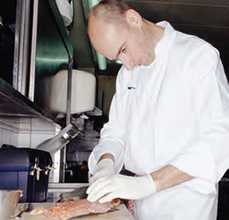Food Worker Handwashing and Food Preparation
This page shows the study purpose, method, results, conclusions, and recommendations in plain language for the EHS-Net project titled Hand-hygiene Study.
The findings and recommendations from this project are also in fact sheet format [PDF - 281 KB].
Citations for more EHS-Net publications are available by Study Topic or by Citation.
Study Problem
The spread of germs from the hands of food workers to food is an important cause of foodborne illness outbreaks in restaurants. In fact, it caused 89% of outbreaks in which food was contaminated by food workers. Proper handwashing can reduce germs on workers’ hands. It can also reduce the spread of germs from hands to food and from food to other people.
The U.S. Food and Drug Administration (FDA) advises that hands be washed before 
- Making food and
- Putting on gloves to make food.
FDA also advises that hands be washed after
- Eating,
- Drinking,
- Using tobacco,
- Coughing,
- Sneezing,
- Using tissue,
- Preparing raw animal products,
- Handling dirty equipment, and
- Touching the body (such as scratching your nose).
Improving food worker handwashing practices is critical. But first we need to know about current practices. We interviewed and watched food workers to collect data on these practices.
Study Purpose
This study described restaurant food workers’ handwashing practices and focused on when workers washed their hands.
Study Findings in Brief
EHS-Net found that food workers carried out about 9 activities an hour that should have involved handwashing. Workers only washed their hands in a quarter (27%) of these activities.
Study Method
Participants
We collected data in 321 restaurants. These restaurants were located in EHS-Net states and were selected at random.
Data Collection
State or local environmental health specialists collected the data. In each restaurant, they watched a food worker for about an hour and collected data on the worker’s activities and handwashing practices. The specialists looked for activities where FDA says handwashing should occur, and then noted whether workers washed their hands. Proper handwashing included removing gloves (if worn), placing hands under running water, using soap, and drying hands with cloths or paper towels.
Study Results
Overall, workers engaged in about 9 activities an hour that should have involved handwashing. Workers washed their hands in only 27% of activities in which they should have. Handwashing rates differed by activity and are described below.
- Before preparing food: 41%
- Before putting on gloves to prepare food: 30%
- After eating, drinking, using tobacco, coughing, sneezing, using tissue: 26%
- After preparing raw animal products: 23%
- After handling dirty equipment: 23%
- After touching body: 10%
Workers were more likely to wash their hands at the right time when they were not wearing gloves than when they were.
Study Conclusions
Workers carried out about 9 work activities an hour that should have involved handwashing. Yet handwashing rates were low. These rates suggest that workers either do not know when to wash their hands or they sometimes choose not to wash their hands.
Handwashing rates were highest before food preparation, suggesting that at least some workers may know that food needs to be protected from dirty hands.
Handwashing rates were lowest after workers touched their bodies (for example after scratching their noses). Workers may not know they need to wash their hands after touching their bodies or may think it takes too much time to wash their hands every time they touch their bodies. They also may not be aware that they are touching their bodies.
Workers wearing gloves when handwashing should occur were less likely to wash their hands at that point than were workers who were not wearing gloves at the same point. For example, workers who were wearing gloves while preparing raw animal product were less likely to wash their hands when they were done than were workers who were not wearing gloves. This suggests that glove use may lead to less handwashing.
EHS-Net Recommends
Restaurant management and food safety programs should
- Work to improve handwashing rates, particularly after activities involving raw meat.
- Revise food preparation activities to lower the number of needed handwashings. For example, a sandwich-making process could be revised to lower the number of times a worker has to handle raw meat. This would lower the number of handwashings needed and should increase the odds that workers will wash their hands as needed.
- Occasionally carry out observations like those done for this study to show where progress in handwashing is needed.
Researchers should conduct research to find out factors that affect handwashing and to explain the link between glove use and handwashing. This information could be used to address barriers to effective handwashing and ultimately reduce illness.
Top of Page- Page last reviewed: March 23, 2017
- Page last updated: March 23, 2017
- Content source:


 ShareCompartir
ShareCompartir